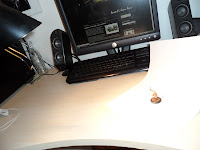This tutorial will show my crude but efficient enough way of getting a good end product with simple means.
.......................
A few things before I proceed with the actual tutorial.
I use a Samsung ST600 camera since before christmas. Prior to that I used the same old Olympus 6 megapixel camera for 5 years and could still take good pictures even though it had less than half the amount of pixels that my new camera has, and where I had to manually crank around what options I needed to use.
Most cameras have a "macro"/"extreme closeup" setting, or like my camera "smart auto" that adjusts to the right conditions. If your camera does not have "smart auto focus" then when you take pictures of models - use the "macro"/"extreme closeup" and position the camera roughly 8"/20cm from the miniature to get the right conditions.
As for the background color I used a toned light blue background for a few years, it is only recently that I swapped to a white background. Other people use black backgrounds. It all really depends on how much contrast you want between the miniature and the background. I've come to like using a completely white background more than the toned light blue one because I feel that the miniature looks "sharper". And using white background just requires a regular white piece of paper that you use for your printer while the toned light blue requires you to print out such a background and you will need to replace the background at a certain frequency as it gets worn.
....................
 So this is how I set up, nothing fancy. White paper resting against my camera mini trip-pod, miniature weight holding the white paper in place. The lamp I use is part of a larger lamp. One "main lamp" and a smaller attached "reading lamp" that can be turned and twisted in all possible angles. I use it when I paint as well as when I take pictures. The lamp is 35W 230V.
So this is how I set up, nothing fancy. White paper resting against my camera mini trip-pod, miniature weight holding the white paper in place. The lamp I use is part of a larger lamp. One "main lamp" and a smaller attached "reading lamp" that can be turned and twisted in all possible angles. I use it when I paint as well as when I take pictures. The lamp is 35W 230V.Here are 4 unedited pictures taken under the following conditions.
......................................................
So let's see what results we can get and highlight the importance of good light during the picture taking process. Apart from what you've seen of my "set up" and the description of my camera - I also use AcdSee Pro 2 for my editing. People mostly use some variety of AcdSee or Photoshop. Both have similar features, I just personally think that AcdSee is more casual user friendly and the loading times of the software are minimal. I use AcdSee both for cropping my pictures, editing and sometimes to apply basic effects such as a sepia or "old faded" filter.
Example 1, the result of editing a picture with bad light.
Example 2, the result of editing the picture that turned yellow due to having the lamp too close to the model.
Or does it? Auto adjust color and contrast almost salvaged this one. And as you can clearly see the model and picture is much brighter than the picture taken with no lights at all. It is still suffering from that "yellowness" inflicted by the lamp though.
Example 3, the result of editing a picture that was taken with good light.
All the difference in the world. Picture is bright, colors represented correctly, the background is pure white as is should be. Picture does not suffer from any tint of yellow or red.
So as you can see taking pictures with crap light or good light often does not show until some editing has been done. You will pretty much only do this simple auto correction to get the most out of the pictures you've taken.
There are 2 more edit options that don't have to be used as frequently but can be used if you like to fine tune a picture end result that still does not reflect how your miniature looks to a 100%.
That pretty much concludes my tutorial. Editing pictures this way, takes about 5 seconds per picture. Click on a picture, go into edit mode, click on "Levels", click "Auto correct" adjust, apply, save and move on to the next.
No comments:
Post a Comment